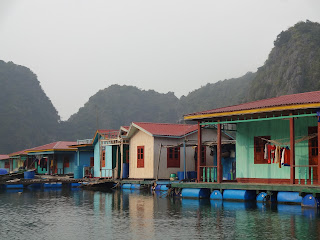I’m closing out my month of travelling with a stop in the
city formerly know as Saigon – now Ho Chi Minh City.
Having been to crowded, chaotic Hanoi, it was quite a
surprise to arrive in a sprawling city that has a modern look to it. HCMC, with
12 million residents, shades more toward Hong Kong than Hanoi, with a number of
upscale shops and fancy hotels mixed in with mom and pop establishments and the
central markets common in Asia.
I am here as the city prepares for Tet, the lunar New Year,
and everywhere I turn, there are workmen and landscapers preparing the public
spaces for the major holiday of the year. Neon and more neon, as well as
flowers galore seem to be the order of the day, and it’s so colourful.
This is the city that was the stronghold of the republic
during the Vietnam War – or American War, as it is called here. In fact, a
coordinated attack throughout the country during Tet in 1975 led Saigon to fall
to the communists and to the U.S. withdrawal.
The war and the government’s attitude towards it are very
much in evidence here at the War Remnants Museum, where displays talk about the
American Imperialists, show the genetic damage done by Agent Orange – something
that continues to be ignored by the U.S. government and the chemical
manufacturers – and present the tiger cages where U.S. prisoners were often
held. No real attempt at balance here!
Nor does one get and understanding of both points of view
during a visit to the Cu Chi tunnels outside the city. These amazing underground
structures were the hideouts for the North Vietnamese as they wrecked havoc on
Saigon and U.S. military bases in the south. Dug deep in the ground and not
large enough for us super-sized Westerners to inhabit, they were places where
the guerillas ate, slept and
manufactured weapons. They are dark and stuffy and a tribute to the
determination of the North Vietnamese, who lived and worked here for a decade,
booby-trapping the ground above the tunnels so that U.S. forces couldn’t get to
them easily.
Our visit to the tunnels started with a 1967 North
Vietnamese propaganda film – very interesting from a historical perspective –
talking about the peaceful village of Cu Chi and how its residents were
fighting back against the evil Americans and were rewarded for their kills.
Egad. There was a retired U.S. Navy man in our group and he was having a
difficult time not choking as the film played on.
The war is also a presence at the city’s Fine Arts Museum,
an amazing colonial structure that is as beautiful as the art it contains. Many
of the paintings and sculptures from the past 50 years have a war theme,
whether depicting brave fighters or villagers uprooted and brokenhearted by the
conflict.
Although Communism may have won the day, capitalism is very
much in evidence, as a visit to the Ben Thanh Market quickly proves. The
hundreds of stalls under the roof of this centrepiece sell fruits and
vegetables, meat and seafood, as well as everything a tourist might desire:
leather goods, shoes, T-shirts, lacquer ware, silk – you name the articles made
in Vietnam and they’re certain to be on display. The hawkers aren’t shy,
either. Thousand of cries of “Madam, madam, what are you looking for?”
reverberate as I walk the aisles. There’s no such thing as discreet browsing!
It’s a lively place, and I’m glad the war is over so I am
able to see that first-hand.















































